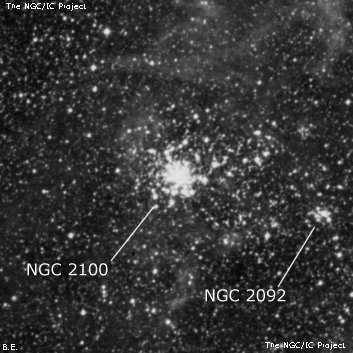
James Dunlop probably discovered NGC 2100 = D 154? on 25 Sep 1826 and reported "a pretty bright round or rather elliptical nebula, 25" diameter." His position is 5.6' ESE of the cluster, well within his typical errors. Glen Cozens assigns D 151 to NGC 2100. Dunlop described this entry as "a faint ill-defined small nebula" and the position is just 2.5' NW of the cluster. Finally, JH also suggest that D 147 might be an equivalence. This entry is 8.4' WSW of the cluster and the description reads "a pretty bright round or rather oval nebula, 30" diameter." This description is very similar to the one for D 154.
On his first sweep of 3 Nov 1834, JH described NGC 2100 = h2966 as "a bright S cluster of distinct stars (thick haze)." On a second sweep he wrote "the cluster sf the great looped nebula." On a third occasion he called it "globular cluster, irr R, psmbM, 2'." His 4th sweep reads "globular, B, R, 3', all resolved into stars 13..16th mag." His final record states "B, S, m compressed, not mbM; irregular oval, 3', stars distinct 13th mag." He noted it might be equivalent to Dunlop 154, 151? or 154??
400/500mm - 18" (7/8/02 - Magellan Observatory, Australia): this LMC cluster appears as a small, bright (V = 9.6) clump of stars and unresolved haze with a diameter of ~2'. Fairly compact and isolated with at least 10 mag 12 and fainter stars resolved. Located 20' ESE of the core of the Tarantula nebula within the LMC OB-association LH 111. On the DSS, this appears to be a very rich open cluster or globular within a larger association. NGC 2092 lies 4' WSW and NGC 2108 is 10' ENE.
Notes by Steve Gottlieb